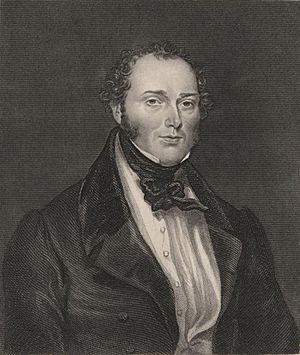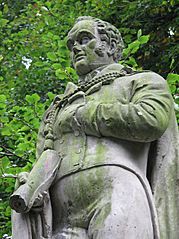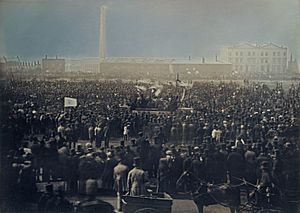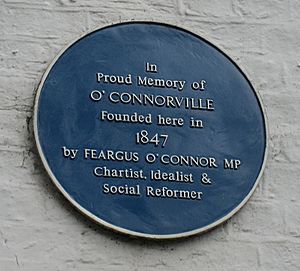Feargus O'Connor facts for kids
Quick facts for kids
Feargus O'Connor
|
|
|---|---|
 |
|
| Member of Parliament for Nottingham | |
| In office 1847–1852 |
|
| Member of Parliament for Cork County | |
| In office 1832–1835 |
|
| Personal details | |
| Born | 18 July 1796 near Castletown-Kinneigh, Ireland |
| Died | 30 August 1855 (aged 59) 18 Albert Terrace, Notting Hill Gate, London, England |
| Political party | Repeal |
Feargus Edward O'Connor (born July 18, 1796 – died August 30, 1855) was an important Irish leader. He was a key figure in the Chartist movement. This movement worked to get more rights for working-class people in Britain. O'Connor also created the Land Plan. This plan aimed to give small pieces of land to working families.
Many people admired O'Connor for his energy and powerful speeches. He was a very popular speaker. His newspaper, Northern Star, was read by many workers. It became the main voice of the Chartist movement. Later in his life, O'Connor's health declined. After he passed away at age 59, about 40,000 people attended his funeral.
Contents
Feargus O'Connor's Early Life
Feargus O'Connor was born on July 18, 1796. His family lived in Connorville house, near Castletown-Kinneigh in County Cork, Ireland. His family was well-known and Irish Protestant. His father, Roger O'Connor, and uncle, Arthur O'Connor, were Irish nationalist politicians. His older brother, Francis, became a general in South America.
Feargus spent most of his early life on his family's land in Ireland. He went to school at Portarlington Grammar School. He also had some schooling in England. He later studied law at Trinity College, Dublin.
Feargus O'Connor's Political Journey
O'Connor's first public speech was in 1822. He spoke in Enniskeen, County Cork. He talked about problems with landlords and the church. He also wrote a pamphlet called State of Ireland. To avoid arrest, he moved to London. He tried to become a writer there.
In 1831, O'Connor supported the Reform Bill in County Cork. This bill aimed to change voting rules. After it passed, he helped people register to vote. In the 1830s, he became a strong supporter of Irish rights. He also pushed for democratic political reform. He criticized the British government's policies in Ireland.
Becoming a Member of Parliament
In 1832, O'Connor was elected to the British House of Commons. He became a MP for County Cork. He was a candidate for the Repeal Association. This group wanted to end the union between Great Britain and Ireland.
In Parliament, O'Connor mostly spoke about Irish issues. He often voted with radical politicians. These were people who wanted big changes. He supported taxes on property. He also supported looking into the conditions of workers in England. He disagreed with Daniel O'Connell, another Irish leader. O'Connor wanted a stronger approach to Irish independence.
In 1835, O'Connor was re-elected. However, he was not allowed to take his seat. This was because he supposedly did not own enough property. But it seems he did have enough property.
Leading the Chartist Movement
From 1833, O'Connor spoke to groups of working men. He pushed for the "Five Cardinal Points of Radicalism." These points were almost the same as the six points of the later People's Charter. In 1837, he started a newspaper in Leeds, Yorkshire. It was called the Northern Star. He worked with others to promote Chartism. He was a representative for the London Working Men's Association.
O'Connor traveled all over Britain, giving speeches. He was one of the most popular Chartist speakers. Some Chartists even named their children after him. He was arrested and jailed several times for his views. In 1840, he was sentenced to 18 months in prison.
The Northern Star newspaper was very successful. It became the most widely bought newspaper outside of London. Feargus's weekly letter on the front page was very popular. It was often read aloud at meetings. The newspaper also shared reports from Chartist meetings across the country. It helped unite and promote the Chartist cause.
When the London Working Men's Association published the People's Charter in 1838, O'Connor supported it. He became the "constant traveling, dominant leader of the movement." He was seen as the main voice of Chartism.
Different Ideas in Chartism
From the start, some Chartist leaders like William Lovett disagreed with O'Connor. They did not like his strong leadership style. O'Connor believed in showing strength through large numbers of people. This was why he organized huge meetings and petitions. He wanted to impress the authorities with the size of the movement.
In 1839, Parliament rejected the first Chartist petition. This petition had 1,283,000 signatures. Tensions grew, leading to the Newport Rising. O'Connor was not involved in planning this event. He was seen as a threat by the authorities. He was sent to York Castle prison for 18 months in May 1840.
While in prison, O'Connor kept writing for the Northern Star. He was now the clear leader of Chartism. A song called Lion of Freedom was written in his honor. It was sung at many Chartist meetings.
In 1842, a new Chartist petition was created. It had 3,315,752 signatures. But Parliament still refused to listen. This made working people even more frustrated. Many strikes happened across Britain in the summer of 1842. Workers wanted better wages and the People's Charter.
Debates with the Anti-Corn Law League
The Anti-Corn Law League was another group. They wanted to end taxes on imported grain. They said this would make bread cheaper. But Chartists argued that without the Charter, cheaper bread would not help much. Workers also did not trust anything supported by employers. They feared that free trade would lower their wages even more. O'Connor strongly made this point. He often debated leaders of the Anti-Corn Law League.
The National Land Company
After 1842, Chartism became less strong. O'Connor then focused on his idea of settling working people on land. He had written about this plan while in prison. He believed that Britain could support its own people if its land was used well.
O'Connor's plan was to buy large pieces of land. This land would then be divided into small plots. Each plot would have a cottage and farm buildings. Working men could buy shares in a company to get this land. The new owners would also get some money to buy farm animals.
The Chartist Cooperative Land Company was formed in 1846. It was later called the National Land Company. It collected over £112,000 from its members. With this money, six small estates were bought. These were divided into smaller plots. In May 1847, the first estate opened at Heronsgate. It was renamed O'Connorsville.
People who got land were chosen by a lottery. They were supposed to pay back their costs with interest. O'Connor and his friend Ernest Charles Jones started The Labourer magazine. It helped promote the project. Soon, hundreds of working people were settled on the land. This plan was very popular among working people.
In 1847, O'Connor was elected as an MP for Nottingham. But the Land Plan faced problems. The government and newspapers started to criticize it. They said it was an illegal scheme.
In April 1848, a new Chartist petition was given to Parliament. It had six million signatures. O'Connor decided not to lead a large march with the petition. He wanted to avoid violence. He feared soldiers might shoot Chartists. An investigation by Parliament later claimed the petition had fewer genuine signatures.
In June 1848, the House of Commons said the National Land Company was illegal. They also said its financial records were not kept well. In July 1849, Parliament voted on the People's Charter. They rejected it by a large margin.
Feargus O'Connor's Final Years
In his last years, O'Connor had disagreements with his friends. The Northern Star newspaper lost readers and money. O'Connor's health was getting worse. Reports about his mental health appeared in newspapers. In 1852, O'Connor visited the United States. His behavior there showed he was not well.
In 1852, O'Connor was sent to a private asylum. He stayed there until 1854. He then moved to his sister's house. He passed away on August 30, 1855, in London. On September 10, he was buried in Kensal Green Cemetery. About 40,000 people came to his funeral. Most Chartists remembered O'Connor for his strengths and leadership.
Feargus O'Connor's Family
Feargus O'Connor never married. However, he had several relationships. It is believed he had children.
Feargus O'Connor's Legacy

Some early historians blamed O'Connor for the failure of Chartism. They said he was too focused on himself and argued a lot. But more recently, historians have started to see him in a better light.
Historian G. D. H. Cole said O'Connor was inconsistent. But he was a true friend to the poor. His strong belief and hope encouraged Chartists. They shared his determination to fight for their political rights. Even if he was sometimes self-centered, perhaps a leader of the people needed to be that way. Especially when facing criticism from the rich and powerful.
Some of his own friends criticized O'Connor. William Lovett called him "the great 'I am' of politics." But George Holyoake described him as "the most impetuous and most patient of all tribunes." He was a powerful leader for the English Chartists.





